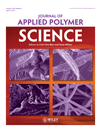Application of lime kiln dust as a filler in the natural rubber industry
Abstract
Lime kiln dust (LKD) obtained from kraft chemical recovery systems by conversion of calcium carbonate (CaCO3) back into calcium oxide (CaO) for reuse in the causticizing process, is mainly composed of CaCO3. A two-stage conventional mixing procedure was used to incorporate LKD into natural rubber (NR). For comparison purposes, four commercial fillers, stearic acid coated CaCO3, ground CaCO3, silica, and carbon black, were also used. The effect of these fillers on the curing characteristics and mechanical properties of NR materials at various loadings ranging from 0 to 60 phr were studied. The results indicate that the use of LKD filler resulted in a lower Mooney viscosity and shorter curing time in the NR materials. The incorporation of LKD into NR improved the Young's modulus and hardness but decreased the tensile strength and tear strength. However, LKD was better in processability than the commercial fillers. Scanning electron micrographs revealed that the morphology of the rubbers filled with reinforcing fillers, such as silica and carbon black, was finer and more homogeneous compared to the those of the rubbers filled with LKD and commercial CaCO3. The dispersion of LKD and commercial CaCO3 fillers in the rubber matrix was discontinuous, which in turn, generated a weak structure compared with the reinforcing fillers. According to these observations, LKD could be used as a cheaper filler for NR materials where improved mechanical properties are not critical. © 2010 Wiley Periodicals, Inc. J Appl Polym Sci, 2011




